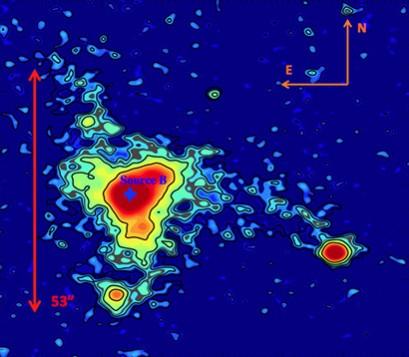![Huge waves are sculpted in this two-lobed nebula called the Red Spider Nebula, located some 3,000 light-years away in the constellation of Sagittarius. [Representational image] nasa, ESA, nebula, luminous, space, Red Spider Nebula,](https://data1.ibtimes.co.in/en/full/637963/nasa-esa-nebula-luminous-space-red-spider-nebula.jpg?h=450&l=50&t=40)
An enormous, radiating nebula has been spotted at the heart of a cluster of early galaxies called a protocluster. This nebula caught the attention of astronomers due to the fact that the source of the powerful light emitted by it remains unknown.
Also Read: NASA's Hubble Space Telescope discovered a stunning 'hybrid galaxy'
This nebula is a glowing blob of gas located in a distant part of the universe, and was spotted by researchers from the Santa Cruz University led by Zheng Cai, a Hubble Postdoctoral Fellow at UC Santa Cruz as the lead researcher.
"Our survey was not trying to find nebulae. We're looking for the most overdense environments in the early universe, the big cities where there are lots of galaxies," Cai said in a statement.
"We found this enormous nebula in the middle of the protocluster, near the peak density," Cai added.

So far, very few such nebulae have been spotted by scientists, they are referred to as -- "enormous Lyman-alpha nebula" (ELAN) — and this one is among the largest and brightest seen so far.
The brilliant glow of the ELANs were previously credited to have originated from quasars -- which are enormous celestial objects that emit enormous amount of energies and appear to be star-like in images taken by telescope. Also, quasars are likely to contain massive black holes.
This study has been published in the journal Astrophysics, which reveals that researchers dubbed the newly-discovered nebula MAMMOTH-1, which is the first one that's not linked to a quasar.
This finding leaves researchers questioning the bright emission of Lyman-alpha radiation by the nebula.
The ELAN is tremendously luminous and it might be more enormous than the 2-million-lightyear-spanning Slug Nebula, J Xavier Prochaska of UC Santa Cruz, a team member explained.
"So it's a terrifically energetic phenomenon without an obvious power source," Science Alert report stated.
The researchers came up with a conclusion that states the MAMMOTH-1 comprises radiations strongly emitted by an active galactic nucleus (AGN), which is covered by dust and goes unseen, leaving behind a very faint source that can be linked back to the nebula.
A super-massive black hole, which feeds on gas at the heart of a galaxy powers the AGN, which is a source of extremely radiant light.









